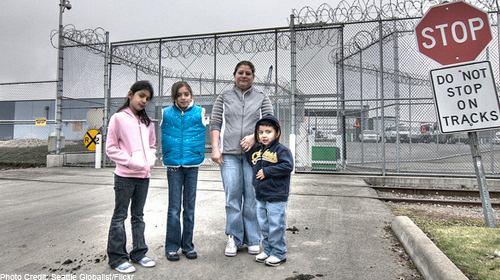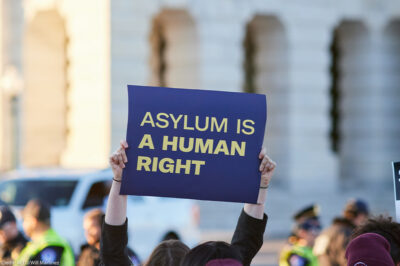
Updated 3/3/2015
Inside the family detention facilities in Karnes County and Dilley, Texas, hundreds of women wait, wondering what the English-only documents say, whether anyone will help them present their asylum cases, and how to care for their children and themselves in the prison-like environment.
Family detention is extremely costly to taxpayers, profits private prison companies, violates due process, and has led to the deaths of children deported to Central America. If the Department of Homeland Security (DHS) appropriations bill passes as is, DHS would receive $362 million to continue to imprison thousands of mothers and children.
A look into DHS’s new family detention facilities shows why we cannot let this happen.
I spent 12 days meeting with more than 30 detained mothers and children at DHS’s new privately owned and operated family detention centers in Texas. In the roll-out of these facilities, DHS made a significant effort to rebrand them as “family-friendly.” “Detainees” became “residents” who are “housed” rather than “detained” in these massive detention complexes. Even the “guards” became “resident assistants.” Fortunately for the government, few make it out to the remote areas where these facilities are located and, consequently, few see the actual conditions in which these women and children are held.
From the outside, the family detention center in Karnes looks like a penitentiary, foreboding and impenetrable in the dusty oil fields of Karnes County. Inside this facility run by the GEO Group – a for-profit prison corporation – over 500 mothers and children are detained behind cinderblock walls and sally port doors. They are subjected to restrictions on every aspect of their daily lives, most troublingly on the way they care for their children. Virtually every mother I interviewed told me that her child or children would not eat and that the water tasted so strongly of chlorine that they rarely drank it.
And notwithstanding the intense security measures, the women and children that I interviewed still did not feel safe. One woman reported feeling terrified at night because detainees cannot lock the doors to their cells and that she often awoke screaming, with visions of her persecutors in her room with her. Others reported that their teenage children had become afraid to sleep alone and crawled into bed with their mothers each night.
The physical toll on the detained children was especially alarming.
During one of my first visits to Karnes, I met Maile, a young mother who was desperate to see me – or anyone – who could help her. She needed a lawyer to explain what was happening in her immigration case and why she and her children had been detained for more than two months. But the more pressing issue for her was Elana, her young daughter, who sat listlessly, staring vacantly at the wall with dark circles under her eyes. Elana had changed since their detention and was receding from the world. Large chunks of her hair had started to fall out and no one at the prison knew why. Maile was therefore considering a decision that no mother should have to make: She wanted to know how to get her daughter out, even if that meant being separated from her child. Sadly, Maile was not the only mother who asked me this question.
Being detained at Karnes also impairs the women’s access to legal counsel and ability to care for their children. To meet with counsel, mothers often have to bring their children with them to the legal visitation room. This means that mothers concerned for their children’s emotional health cannot fully describe the dangerous – and often sexualized – persecution from which they fled. These conditions make attorney-client meetings difficult and time consuming.
It took several interviews with Amalia, a young mother detained at Karnes, to get her full story. At our first meeting, Amalia explained that Lolia, her daughter, was in turmoil after witnessing men repeatedly sexually assault her mother. Since they arrived at the detention center, Amalia had been punished for Lolia’s acting out. We cut our meeting short so that we could continue without Lolia present. However, Lolia came to our second meeting and was clearly very ill. Her eyes looked glassy, her hair was stringy, and she leaned on the table, lifting her head only to cough. Amalia picked up Lolia’s matted hair, explaining apologetically that Lolia had been vomiting as they waited several hours at the medical clinic that morning. Eventually, Lolia’s coughing became so severe that I worried she might choke.
“Do you want to give her some tea?” I asked. Amalia looked at me blankly and said, “We can’t, we are only given cold water.” When I asked three guards idling in the visitation area for hot water for Lolia, they refused and said that Amalia and her daughter would have to return to the clinic – and presumably wait another few hours. Because Amalia couldn’t give up a rare opportunity for legal counsel, she simply drew Lolia close, rubbed her back, and continued to describe the brutal rape and beatings from which she and Lolia fled. As a mother detained at Karnes, she had little choice but to do this.
In contrast to Karnes, the facility in Dilley, Texas, doesn’t look like a traditional prison. Instead, this sprawling ex-labor camp, encircled by a chain-link fence resembles an internment camp. The Dilley facility, run by the for-profit Corrections Corporation of America through a contract with Eloy, Arizona, is remote and still under construction. Once completed, it will hold 2,400 women and children.
As I approached the trailer where legal visits are held, I saw a young boy. He sat in the foyer, swinging his legs and plaintively asking “Cuando vamos a ir?” – “When are we going to leave?” – in an endless loop as his mother spoke to the guards.
What is most surprising about the visitation center in the facility is that it looks utterly untouched. I noticed, and continued to note over the course of four trips, the complete absence of attorneys. Unsurprisingly, word spreads like wildfire when there’s any attorney around, and I spoke to more women than planned. I unfortunately couldn’t answer their most pressing question: What do I have to do to get an attorney here?
Nor are there good answers for attorneys who want to help. The Dilley facility is far from any major cities. Attorneys who are able to make the trip will find it difficult to confirm that they can see their client before driving hours to the detention center. My many calls to the main facility number to get confirmation were rarely unanswered. The facility’s isolation makes the representation crisis acute. If, as DHS intends, Dilley’s population will increase six fold by the end of 2015, it will be yet another example of DHS’s enforcement tactics creating a “crisis squared.”
Bottom line?
There’s nothing “friendly” about how the government is treating children and mothers fleeing brutal violence and seeking protection in the U.S. As Sen. Patrick Leahy (D-Vt.) said during a Senate floor speech this week, opposing the new funding for family detention, “Incarcerating women and children fleeing violence runs contrary to our long history as a nation that offers refuge to those most in need.”
*The names in the blog have been changed to protect the identity of those listed.
Learn more about immigration reform and other civil liberty issues: Sign up for breaking news alerts, follow us on Twitter, and like us on Facebook.




